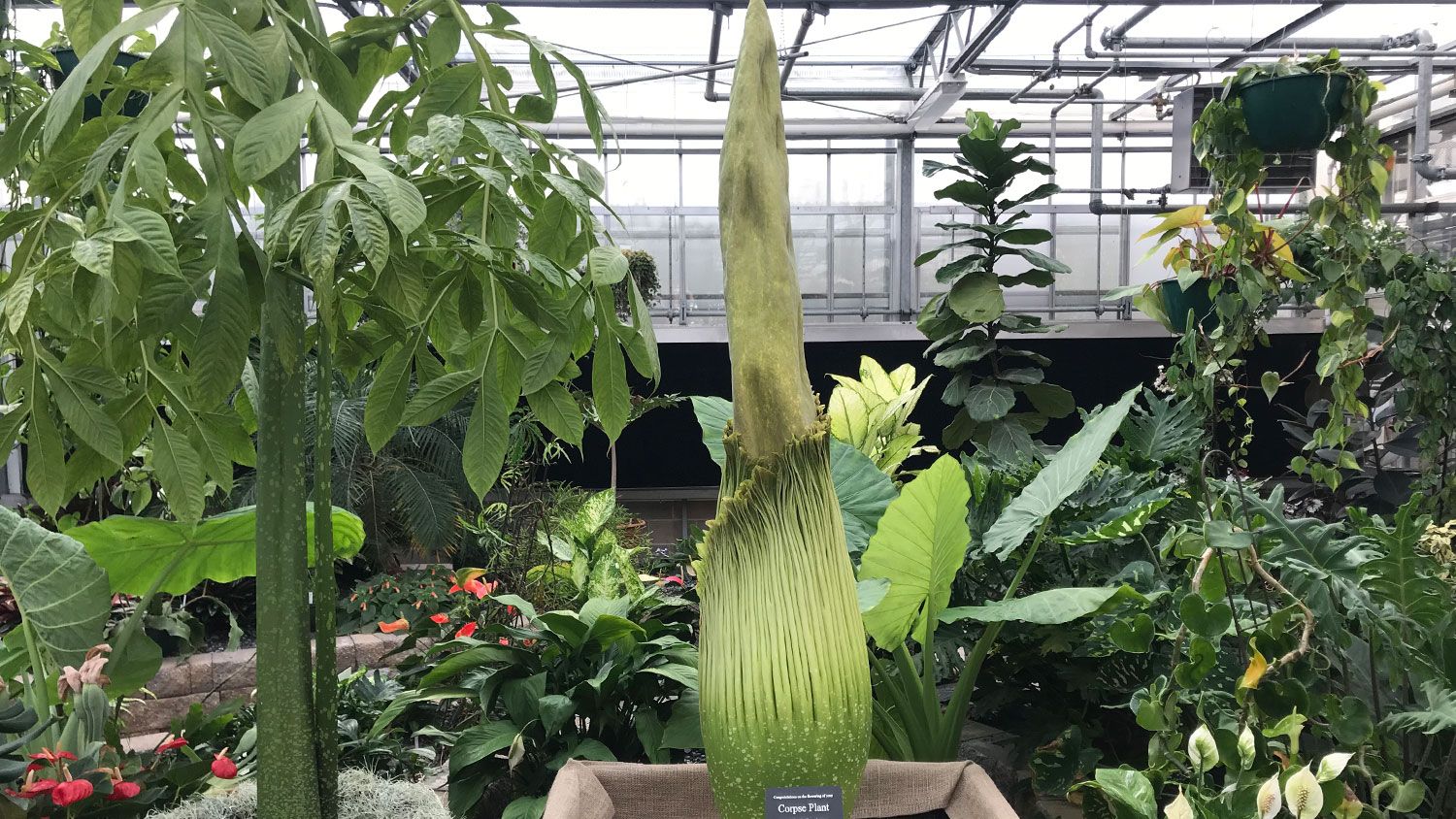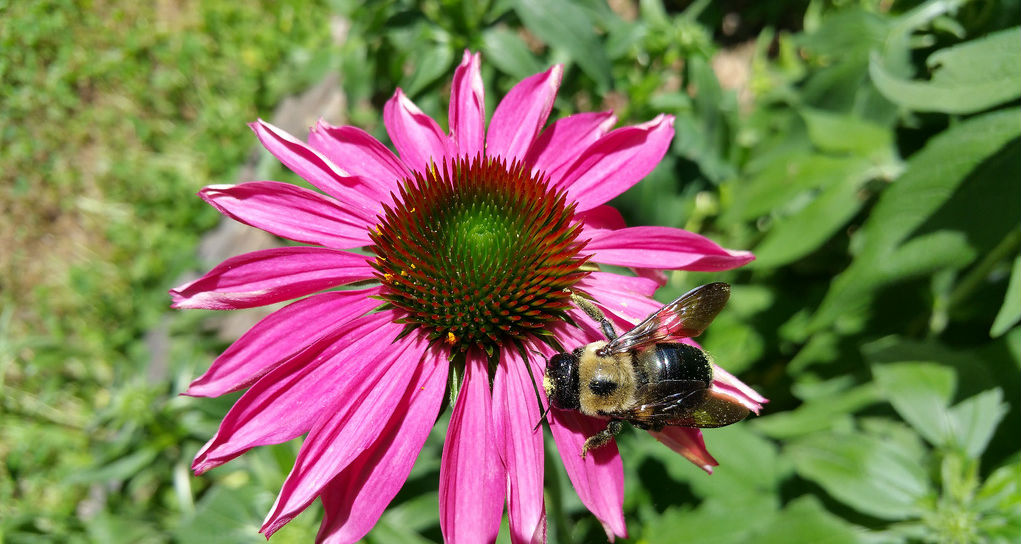NC State’s Corpse Flowers
Rare plants that put on a spectacular show --- and make a big stink.
*This bloom occurred in 2023. There are no current corpse flowers on display at JC Raulston Arboretum.
What’s All The Stink About?
Wolfgang, NC State’s youngest corpse flower, or titan arum, bloomed for the first time at the JC Raulston Arboretum (JCRA) in Raleigh, North Carolina, in 2023. Currently, there are no blooming corpse flowers on display.
The campus community fondly refers to our initial titan arum (Amorphophallus titanium) as Lupin, and its cousin, Wolfgang, is 8 years old. Corpse flowers — one of the biggest, stinkiest flowers in the plant kingdom — release a rotting flesh smell as they bloom.
The titan arum is located outside the Ruby C. McSwain Education Center next to the Cascade Fountain.
For a pungent-free view, watch the livestream video at https://go.ncsu.edu/corpseflowerlive or follow along with social media updates with #StinkyPack.
Everything You Wanted to Know About a Corpse Flower …
And More …
Facts About Corpse Flowers
Scientists at NC State watched a tropical plant closely as it bloomed in late September 2016, sending out not just a big flower — one of the biggest in the plant kingdom — but a big stink as well.
During all corpse flower blooms, the plant grew to be more than 5 feet tall and unfolded into a magnificent flower around 3 feet wide.
From Beginning to Bloom
How a Corpse Flower Took Root at NC State
Brandon Huber, who received his Ph.D. in horticultural science in May 2021, received his titan arum 11 years ago when he was visiting the Huntington Botanical Gardens in California. Then, it was a dormant 4-year-old corm, an underground stem about the size of a softball. The corm now weighs about 60 pounds, down from its heaviest weight of 120 pounds in 2019. Huber brought the titan arum with him to NC State.
The plant’s first bloom in 2016 came amid a rash of corpse flower blooms nationwide. Only a few hundred Amorphophallus titanum blooms have occurred in cultivation in the past 132 years since the first one bloomed in London.
Huber and Diane Mays, who curates the greenhouse conservatory where the plant is held, both said the blooms have been fascinating events for plant lovers. “I feel like I have a front-row seat. To have it in our region and our greenhouse, we feel very special,” Mays says. “It’s such a spectacular plant.”
A Howlingly Pungent Flower Named Lupin
How the Plant Came by Its Name
To honor the plant’s connection to NC State, Huber has named it Lupin, after Remus Lupin, a werewolf from the Harry Potter series whose name comes from the Latin word meaning wolf. You can follow the plant’s progress on Instagram and Twitter using the hashtag #Lupin2016.
There are three titan arums growing in the NC State University’s conservatory greenhouse. Lupin (the original corpse flower that is named after the Werewolf in the Harry Potter series), Wolfgang and a yet-to-be-named clone of Lupin.
Huber is trying to create new Amorphophallus hybrids by crossing titanum with other more hardy species. His goal: to create a hardy plant that gardeners can grow outside.
About Wolfgang
Wolfgang’s Name and Family Tree
In 2017, Diane Mays was given a dormant corm of Amorphophallus titanum from Ohio State University’s Biological Science Department.
Before Wolfgang came Lupin the corpse flower. Brandon Huber, the owner of Lupin, came up with the nickname after Remus Lupin from the Harry Potter series. Keeping the NC State Wolfpack theme, Diane Mays proudly named the titan arum Wolfgang. Wolfgang is presenting its first bloom in the middle of June 2023.
Wolfgang the corpse flower comes from a cross between Ohio State University’s Maudine and Woody. In May 2013, the Biological Science Department at OSU used fresh pollen from Woody to pollinate Maudine during the peak bloom period. Woody had bloomed a week prior to Maudine, and samples were collected, saved, and sent all over the world for future preservation.
The cross yielded several seeds, including Wolfgang. At 4 years old, Wolfgang was sent to NC State’s Department of Horticultural Science. Wolfgang was the largest corm delivered by Ohio State University. For the past six years, Wolfgang has lived in Marye Anne Fox Science Lab Greenhouse. Titan arums need hot and humid conditions resembling their native habitat on the Island of Sumatra, Indonesia.
Corpse Flower Quick Facts
What is a titan arum, or corpse flower, and why do horticulturists care about something that smells like spoiled meat?
Because It’s a Rarity in the Plant Kingdom
- The titan arum has one of the largest flowering structures in the plant kingdom. While this structure looks like a huge single flower, it’s actually an inflorescence, or stalk of many flowers.
- The titan’s flowers grow at the base of the central phallus-like structure, or spadix, and are hidden by a skirt-like covering called a spathe. The spathe is bright green on the outside, and when it blooms, it reveals a deep burgundy on the inside.
- The rare titan arum is a tropical plant, having been found by Italian botanist Odoardo Beccari in Sumatra, Indonesia, in the late 1800s. It grows near the edges of rain forests, which means it needs warm day and night temperatures and high humidity.
Because It’s Got Some Cool Names
- The plant got its common name, “titan arum,” from the naturalist Sir David Attenborough, who thought viewers of his BBC series The Private Lives of Plants would be offended by the plant’s Latin name, Amorphophallus titanum, or giant misshapen penis.
- The titan arum is sometimes called the “corpse flower” because when it blooms, it smells like rotting flesh. The smell attracts insects such as carrion beetles and flies that pollinate the plant.
Because It Has a Unique Life Cycle
- Titan arums can, in theory, live indefinitely. Pollinating the plants can sometimes kill them as it sucks a great deal of energy from the plant. They are also at risk from pathogens.
- During its life cycle, the titan arum produces one large single leaf at a time. The leaf’s petiole looks like the trunk of a small tree, reaching 10 to 15 feet. After about 15 or 16 months, it goes dormant. After dormancy, it will either grow another single leaf or bloom, with the bud taking months to form. After it breaks the soil surface, it will grow steadily for a few weeks.
- When the inflorescence finally opens fully, it remains open for a day or two before collapsing and restarting the life cycle. Blooms are typically from 4 to 8 feet tall.
- In cultivation, pollination requires pollen from a separate titanum flower because the titan arum’s female flowers are receptive before the male flowers produce pollen. Therefore it requires hand pollination.
- If the titan arum is pollinated, the female flowers turn into bright orange-red fruits. Inside the fruits are seeds that can develop into new corms.
- As the plant blooms, it actually heats up to human body temperature. That heat allows the stench to carry farther, and it also helps attract pollinators.
- It takes at least seven years for the titan arum to bloom for the first time, and sometimes it can take even longer. The one in NC State University’s conservatory greenhouse took 13 years to bloom for the first time.
- Subsequent blooms often occur every three to seven years for the rest of the plant’s life. Lupin’s third bloom will arrive a little early; it’s been just two years since it last bloomed.
Sources
- Brandon Huber, Ph.D.
- Biological Sciences Greenhouse, Ohio State University
- United States Botanical Garden
Fun Fact
The titan arum typically takes 7-10 years of vegetative growth before it blooms for the first time.

Support Our Horticultural Science Students
Your donations help us cultivate new, invaluable experiences for our students and showcase astonishing plants like our Titan arum, Wolfgang!
Support the Department of Horticultural Science and JC Raulston Arboretum by making a gift to the JC Raulston Arboretum Internship Fund.
Funds supporting JC Raulston Arboretum Internship Fund and the Department of Horticultural Science are collected and managed by The North Carolina Agricultural Foundation, Inc., a 501(c)(3) organization, tax ID #56-6049304.
Keep Up with the Corpse Flower
You can continue to follow Lupin’s progress on Twitter and Instagram at #Lupin2016 – named for its original bloom year.
NC State Department of Horticultural Science

Additional Information
Visit Brandon Huber’s photo gallery for more images of Lupin’s evolution.